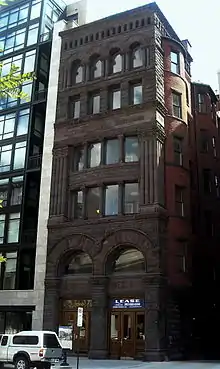
Glenn Brown
Glenn Brown (1854–1932)[1] was an American architect and historian.
He wrote a two-volume History of the United States Capitol (1901 and 1904) and more than 100 articles.[1] In 1927, Brown was elected into the National Academy of Design as an associate member.[2]
Several of his works are listed on the U.S. National Register of Historic Places.[3]
Works include:
- Joseph Beale House, 2301 Massachusetts Ave., NW., Washington, D.C. (Brown, Glenn), NRHP-listed
- Dumbarton Bridge, Q St. over Rock Creek Park, NW., Washington, D.C. (Brown, Glenn & Bedford), NRHP-listed
- Glenwood Cemetery Mortuary Chapel, 2219 Lincoln Rd., NE, Washington, D.C. (Brown, Glenn), NRHP-listed
- National Union Building, 918 F St., NW, Washington, D.C. (Brown, Glenn), NRHP-listed
- One or more works in Fourteenth Street Historic District, roughly bounded by S, 12th, N and 15th Sts., NW., Washington, D.C. (Brown, Glenn, et al.), NRHP-listed
He also directed restoration works at Pohick Church beginning in 1901. [4]
References
- 1 2 William B. Bushong and Catherine W. Bishir (2009). "North Carolina Architects & Builders: Brown, Glenn (1854–1932)".
- ↑ "National Academicians | National Academy | National Academy Museum". Archived from the original on 2016-03-14. Retrieved 2013-11-26.
- ↑ "National Register Information System". National Register of Historic Places. National Park Service. July 9, 2010.
- ↑ Calder Loth; Virginia. Dept. of Historic Resources (1999). The Virginia Landmarks Register. University of Virginia Press. pp. 160–. ISBN 978-0-8139-1862-4.
This article is issued from Wikipedia. The text is licensed under Creative Commons - Attribution - Sharealike. Additional terms may apply for the media files.
